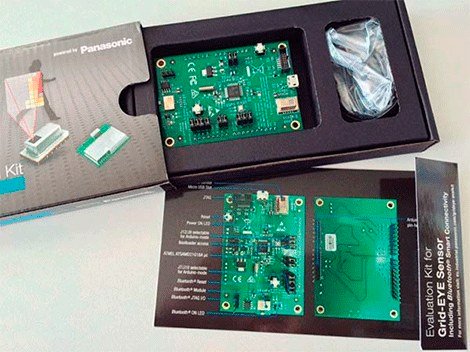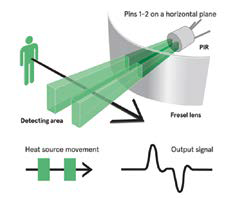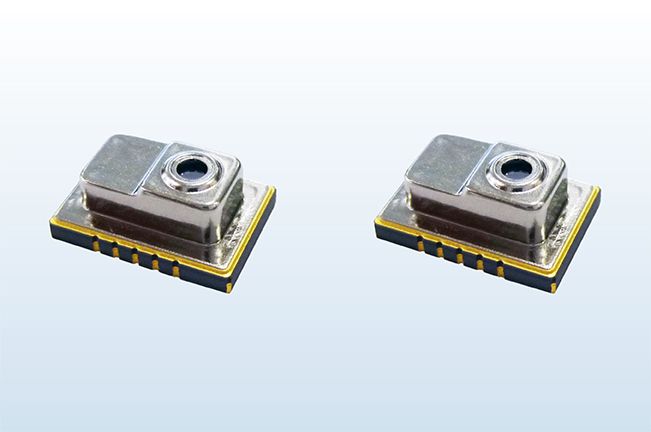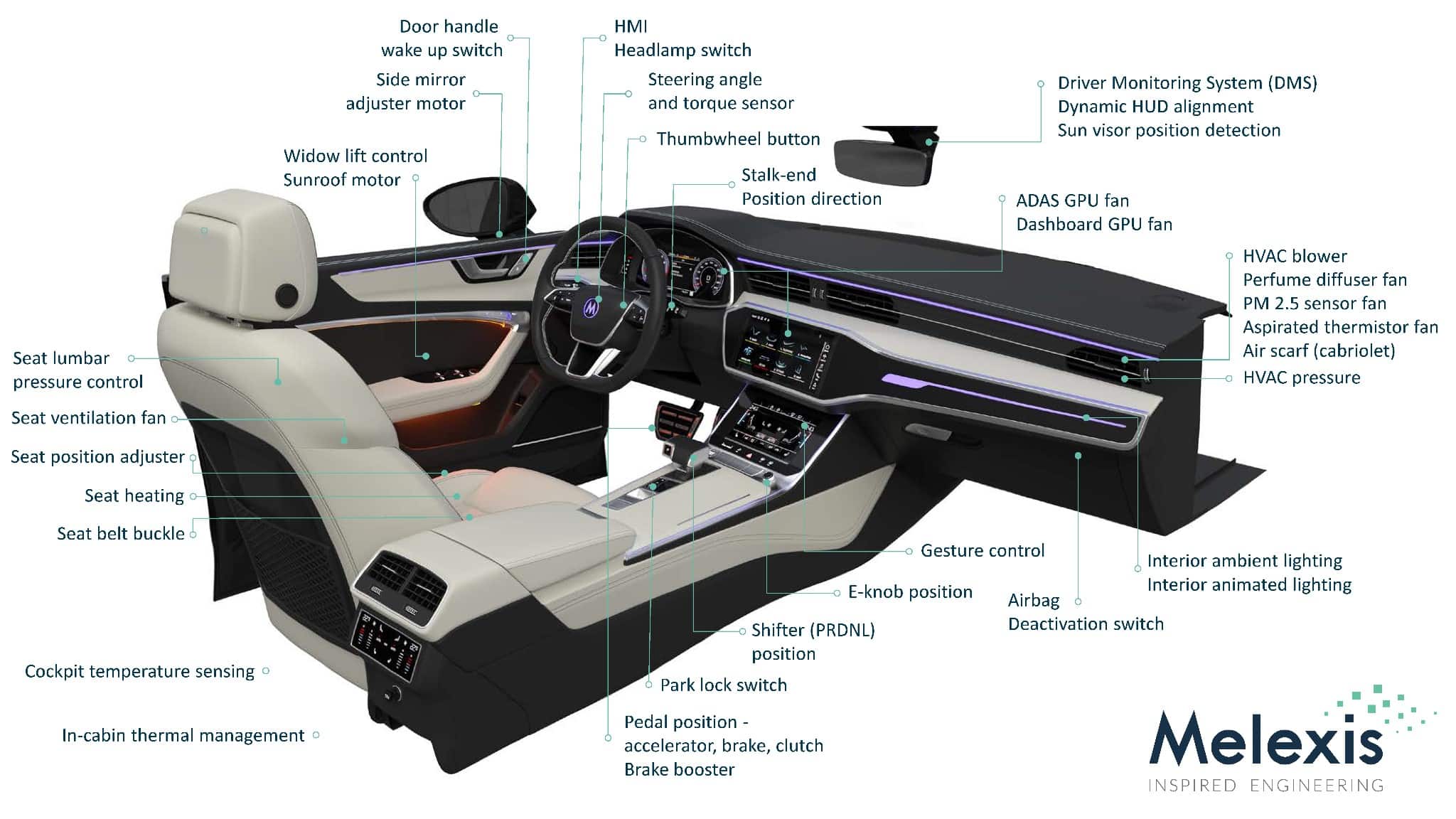Engineers in the field of general lighting are focused on designing compact, intelligent and energy-efficient systems that could be achieved by adding the function of automatic shutdown when no human presence is detected. Today, these smart sensors are mostly based on PIR (Passive Infrared) technology, which is well suited for detecting human movement over a wide range in a large detection area, but is not effective. for small movements and is also unable to distinguish between objects that are approaching and moving away. Radar sensors are capable of carrying out many of the functions that PIR sensors cannot, but their principle of operation is also based on movement, and although they are usually capable of detecting small movements, they cannot detect stationary objects. Since direction detection is limited to zooming in and out, it is often not easy or possible to perform special functions such as counting people entering or leaving a room. People who are in an office without making any perceptible movement will be considered as not present with these devices. Panasonic's GridEye sensor is based on a matrix detector and acts as a low-resolution thermal camera, making it ideal for presence detection. By evaluating the thermal image using a microprocessor-based host system, more complex observations can be made. By integrating this sensor into a building automation or smart lighting system, problems encountered with PIR or radar sensors can be avoided. This technological article offers a comparison of the technologies indicated above.
PIR sensors
The passive infrared sensor (or PIR) detects changes in the flow of heat caused by the movement of the human body, which is in contact with the environment and alters its temperature. The radiation moves in the infrared range with a maximum wavelength of 9,4 µm, which the pyroelectric materials of the PIR sensor detect, generating energy in response. Pyroelectric elements show ferroelectric behavior and are characterized by a certain permanent electrical polarization on the surface of the elements. However, the polarization is not detectable because the surface charges are offset by some charged ions in the surface environment. When infrared radiation hits pyroelectric elements, their temperature rises very little. As a consequence of thermal expansion, the crystalline structure must be rearranged and therefore the surface polarization of the elements changes. This change in polarization can be detected by the electrodes on the top and bottom of the pyroelectric elements. The electrical charge required to compensate for the change in electrical polarization is sensed and amplified by an internal Field Effect Transistor (FET). Each temperature change of the elements causes a brief disturbance in the output signal of the FET that is used to detect the presence of a human body. The changes in polarization are very small and therefore it is necessary that these changes be fast enough for the FET to detect them. For this reason, only moving infrared emission sources can be detected. In order to be able to cancel false signals resulting from temperature changes, there are at least two pyroelectric elements connected in series with antiparallel polarization.
In terms of construction, PIR detectors feature a Fresnel lens to focus radiation onto the sensor elements, as well as dual or quad elements to subtract ambient temperatures and reduce the number of false alarms. PIR sensors can detect horizontal movements correctly, but they cannot always detect radial movements. There are also smart digital PIR sensors such as Nicera's Pyroelectric Passive Infrared Sensor (PIR Sensor).
This device is a digital output pyrosensor, but does not require communication with a microcontroller. In case of detection of a moving object (human being), the output voltage on the connectors is high (Vdd-1V min) during a preset operating time, and low (<1V) the rest of the time. The configuration of the operating time and sensitivity is done by applying the appropriate voltage values in the connectors corresponding to the sensitivity and operating time. Thanks to this product, a detector can be designed using only a few external devices.
The disadvantages of PIR technology are the need for the Fresnel lens and the ability to detect only large human movements in the tangential direction.
radar sensors
Radar sensors can detect slight movements of the human body and, if integrated into a smart system, could solve the problems posed by PIR sensors. However, to meet all the requirements, these sensors must be very small, low cost, low power and low power consumption.
In the past, it was only possible to install radar systems using expensive, large, and heavy components such as waveguides. Today, thanks to planar technology, sensor modules are small, efficient and robust.
Radar modules emit electromagnetic radiation in the radio frequency range of 18…27GHz, the so-called K band. A part of that range, from 24…24,250 GHz, corresponds to the ICM (Industrial, Scientific and Medical) radio frequency band. The use of the K band is allowed practically everywhere in the world without limitations. Solid objects reflect radar radiation and the reflected radiation is used to detect objects. The amount of reflected radiation that the radar module detects depends not only on how far away the object is, but also on its size and material.
A metallic surface is a very good target for radar due to its high reflection, and even a human being reflects quite satisfactorily thanks to the high er value (value of the water contained in the body). Even the smallest standard modules are capable of detecting a person at a distance of 12 meters. Many of the plastic materials are more or less transparent to microwave radiation. Therefore, the sensor module can be easily hidden behind a plastic panel, which is a huge advantage for the exterior design of the final product compared to pyroelectric detectors, which require a Fresnel lens to function properly.
The operation of these sensors is based on the Doppler effect to calculate the speed data of objects at a certain distance. The reflected signal that is radiated towards the desired target has an altered frequency. This variation provides direct and highly accurate measurements of the radial component of the target's velocity relative to the radar. The difference between the reflected frequency and the emitted frequency of a wave for an observer moving relative to the source of the wave is called the Doppler shift. For example a vehicle equipped with a siren approaches, passes, and moves away from a stationary observer. The received frequency is higher (compared to the emitted frequency) when approaching, it is identical when overtaking, and it is lower when moving away. This change in frequency also depends on the direction in which the source of the wave is moving relative to the point of observation. Doppler radar is used to detect moving objects and assess their speed. A moving reflective object within the sensor field generates a sine wave, which is proportional to the speed of the object.
The frequency transformation could be described by the following formula:
Freflexed= Femitted (1+v/c) / (1-v/c)
where v is the speed of the object and c is the speed of light. The Doppler frequency is as follows:
Fd = Freflected – Femitted = 2 v Femitted /c, which is proportional to the speed of the moving object.
The amplitude depends on the distance and the reflectivity of the moving object.
Accurate speed measurement is a very useful feature, many RfBeam microwave radar sensors are capable of doing so even in the highest speed ranges.
However, to detect the presence of humans with microwave technology, it is enough to be able to measure a speed of 1 m/s (3,6 km/h), but it is necessary to be able to use a very small, cheap and simple detector.
New Japan Radio Corporation WaveEye K-band Doppler sensor
While conventional microwave sensors or modules need a complete circuit around them to be able to control, for example, an intelligent lighting system, there are certain easy-to-use integrated motion detector modules that are based on Doppler effect technology. with 24 GHz microwave. One of them is the NJR4265 from New Japan Radio Corporation, where the antenna, RF circuit, IF amplifier, MCU unit and voltage regulator are integrated in a small size of 14 x 20,4 .8,8 x XNUMXmm.
NJR4265 J1 is an intelligent motion sensor designed to detect low-speed moving objects over short distances, such as pedestrians. Fixed detection of moving objects is performed by integrated software. This software with this built-in detection function is useful in various devices, as all the functions are integrated in a small size and can be easily controlled from a PC/MCU with a UART interface, but can also be used separately.
The signal processing software is in charge of fixed detection, improving the signal of the moving object and reducing random noise, as well as limiting interference between sensors. Likewise, it is also capable of identifying the direction of movement (approaching or moving away).
The device is characterized by a low operating voltage, 3,3-5V, and low power consumption. In sensing mode, the operating current is 60 mA, while in steady state it is 4 mA.
The schematic diagram shows us that the Patch antenna and RF circuitry have been integrated into the analog filtering and signal processing circuitry.
The radiation pattern indicates that this microwave sensor can detect movement in both horizontal and vertical directions, which is a considerable advantage over PIR technology. The maximum detection range is 10 meters in +/-35° with an approach speed of 0,25-1 m/s, which is measured as indicated in the figure. An evaluation kit is available to test the device that converts the UART interface to USB so that the device can be connected to a PC. The provided software will be capable of detecting an approach and departure movement as shown in the screenshots.
The device can be used in combination with the MCU/PC, in which case it is the processor that sets the parameter range.
When used separately, this range of parameters are set using a potentiometer.
In both cases, the LED indicator could be replaced with a control circuit that could be used to interface with the system that needs to be controlled based on motion, such as turning the light on when a person approaches and off when the person leaves. move away
Application Examples
Since the NJR4265 device is small and based on microwave radar technology, it is easy to integrate into an embedded system. The price range is very attractive and its simple installation and operation mean that this device can be used instead of PIR-based systems, or in a complementary way. The field of application is wide, although the most common uses are the movement switch of automatic doors, the movement switch of lighting systems or the additional energy saving functions of television, air conditioning or PC systems. Since Doppler technology makes it possible to use this device to measure speed, it can also be used to detect golf or tennis, for example.
The Doppler rate calculation given above is based on the direction of motion being straight towards the sensor. Taking into account the angle between the direction of the moving object and the direction of the emitted radar beam, with a typical radar frequency of 24 GHz and a speed of light of 3X108 m/s, the Doppler frequency can be calculated. as follows:
If the direction of the radar beam is perpendicular to the direction of movement of the object, the angle will be 90o, therefore -as can be seen in the formula- detection will be complicated. Although radar sensors are capable of detecting relatively small movements and even the direction of movement (limited to approach or departure), difficulties arise with stationary objects. For example, the usual technology behind lighting sensors in hotel bathrooms does not work properly when the user is not moving.
Considering that PIR and radar sensors cannot detect the number of moving objects and may experience problems with direction detection, they cannot carry out some special functions such as counting or controlling people's movements in a room. stay.
GRID-EYE thermal sensor
Panasonic's new Grid-Eye infrared sensor device is a thermopile type infrared sensor, which detects the amount of infrared rays.
These highly accurate sensors, based on advanced MEMS technology, feature absolute temperature sensing, thanks to a two-dimensional 8×8 “pixel” surface with an I2C digital output and a miniature SMD (Surface Mount) size. .
The Grid-EYE device is capable of detecting temperature and temperature gradients without contact along the entire indicated surface with a viewing angle of 60º thanks to the integrated silicon lens, offering a thermal image of the observed environment.
It easily differentiates multiple objects and identifies the direction of movement by evaluating the single thermal image, while having no privacy rights violation issues.
Its cost-efficient yet highly accurate applications can be realized by connecting the sensor to the host microcontroller using an I2C digital communication interface and reading out at speeds between 1-10 fps. The output interrupt function can be used to trigger immediate actions based on detection criteria. The 64 pixel performance for precise temperature measurement offers the possibility of detection based on body shape.
The table above contains a comparison between motion detection technologies and GRID-EYE, where the advantages of GRID-EYE are evident.
Detection of human bodies is possible thanks to contactless temperature measurement. The different colors of the pixels represent the temperature gradients.
As the detection distance increases, the size of the thermal image of the detected object approaches the size of the pixel. From a greater distance, multiple objects can be distinguished in the thermal image.
By using the Grid-Eye sensor from a greater distance, there is the possibility of monitoring all movements or detecting various people.
By using the sensor for closer detection, the critical points of the body can be detected:
Using the sensor on a car dashboard in close sensing mode, Grid-Eye is able to detect gestures and activate or control various functions.
Application area:
Safety:
-Detection of occupants.
-People counting, multi-person detection.
Domestic applications:
– Ovens, microwaves.
- Air conditioners.
- Heating systems.
Medical Applications:
– Control of patients.
– Movement detection.
– Thermal images.
– Position detection.
General lighting:
– Energy saving.
– Detection of presence without movement.
Industrial temperature measurement:
-Process control.
-Temperature measurement without contact.
With the goal of contributing to the rapid development of sensor systems and their short-term commercialization, Panasonic offers an evaluation board for the Grid-Eye sensor.
This tiny Arduino PCB contains a USB communication interface, the sensor, an ATMEL microprocessor and also a low power smart PAN1740 bluetooh module.
This kit enables rapid prototyping and by combining the latest generation IR sensor with bluetooth technology, engineers will be able to create their wireless sensor IoT (Internet of Things) applications in no time.
Available PC software and smartphone apps provide additional support for developers.
PIR sensors
The passive infrared sensor (or PIR) detects changes in the flow of heat caused by the movement of the human body, which is in contact with the environment and alters its temperature. The radiation moves in the infrared range with a maximum wavelength of 9,4 µm, which the pyroelectric materials of the PIR sensor detect, generating energy in response. Pyroelectric elements show ferroelectric behavior and are characterized by a certain permanent electrical polarization on the surface of the elements. However, the polarization is not detectable because the surface charges are offset by some charged ions in the surface environment. When infrared radiation hits pyroelectric elements, their temperature rises very little. As a consequence of thermal expansion, the crystalline structure must be rearranged and therefore the surface polarization of the elements changes. This change in polarization can be detected by the electrodes on the top and bottom of the pyroelectric elements. The electrical charge required to compensate for the change in electrical polarization is sensed and amplified by an internal Field Effect Transistor (FET). Each temperature change of the elements causes a brief disturbance in the output signal of the FET that is used to detect the presence of a human body. The changes in polarization are very small and therefore it is necessary that these changes be fast enough for the FET to detect them. For this reason, only moving infrared emission sources can be detected. In order to be able to cancel false signals resulting from temperature changes, there are at least two pyroelectric elements connected in series with antiparallel polarization.
In terms of construction, PIR detectors feature a Fresnel lens to focus radiation onto the sensor elements, as well as dual or quad elements to subtract ambient temperatures and reduce the number of false alarms. PIR sensors can detect horizontal movements correctly, but they cannot always detect radial movements. There are also smart digital PIR sensors such as Nicera's Pyroelectric Passive Infrared Sensor (PIR Sensor).
This device is a digital output pyrosensor, but does not require communication with a microcontroller. In case of detection of a moving object (human being), the output voltage on the connectors is high (Vdd-1V min) during a preset operating time, and low (<1V) the rest of the time. The configuration of the operating time and sensitivity is done by applying the appropriate voltage values in the connectors corresponding to the sensitivity and operating time. Thanks to this product, a detector can be designed using only a few external devices.
The disadvantages of PIR technology are the need for the Fresnel lens and the ability to detect only large human movements in the tangential direction.
radar sensors
Radar sensors can detect slight movements of the human body and, if integrated into a smart system, could solve the problems posed by PIR sensors. However, to meet all the requirements, these sensors must be very small, low cost, low power and low power consumption.
In the past, it was only possible to install radar systems using expensive, large, and heavy components such as waveguides. Today, thanks to planar technology, sensor modules are small, efficient and robust.
Radar modules emit electromagnetic radiation in the radio frequency range of 18…27GHz, the so-called K band. A part of that range, from 24…24,250 GHz, corresponds to the ICM (Industrial, Scientific and Medical) radio frequency band. The use of the K band is allowed practically everywhere in the world without limitations. Solid objects reflect radar radiation and the reflected radiation is used to detect objects. The amount of reflected radiation that the radar module detects depends not only on how far away the object is, but also on its size and material.
A metallic surface is a very good target for radar due to its high reflection, and even a human being reflects quite satisfactorily thanks to the high er value (value of the water contained in the body). Even the smallest standard modules are capable of detecting a person at a distance of 12 meters. Many of the plastic materials are more or less transparent to microwave radiation. Therefore, the sensor module can be easily hidden behind a plastic panel, which is a huge advantage for the exterior design of the final product compared to pyroelectric detectors, which require a Fresnel lens to function properly.
The operation of these sensors is based on the Doppler effect to calculate the speed data of objects at a certain distance. The reflected signal that is radiated towards the desired target has an altered frequency. This variation provides direct and highly accurate measurements of the radial component of the target's velocity relative to the radar. The difference between the reflected frequency and the emitted frequency of a wave for an observer moving relative to the source of the wave is called the Doppler shift. For example a vehicle equipped with a siren approaches, passes, and moves away from a stationary observer. The received frequency is higher (compared to the emitted frequency) when approaching, it is identical when overtaking, and it is lower when moving away. This change in frequency also depends on the direction in which the source of the wave is moving relative to the point of observation. Doppler radar is used to detect moving objects and assess their speed. A moving reflective object within the sensor field generates a sine wave, which is proportional to the speed of the object.
The frequency transformation could be described by the following formula:
Freflexed= Femitted (1+v/c) / (1-v/c)
where v is the speed of the object and c is the speed of light. The Doppler frequency is as follows:
Fd = Freflected – Femitted = 2 v Femitted /c, which is proportional to the speed of the moving object.
The amplitude depends on the distance and the reflectivity of the moving object.
Accurate speed measurement is a very useful feature, many RfBeam microwave radar sensors are capable of doing so even in the highest speed ranges.
However, to detect the presence of humans with microwave technology, it is enough to be able to measure a speed of 1 m/s (3,6 km/h), but it is necessary to be able to use a very small, cheap and simple detector.
New Japan Radio Corporation WaveEye K-band Doppler sensor
While conventional microwave sensors or modules need a complete circuit around them to be able to control, for example, an intelligent lighting system, there are certain easy-to-use integrated motion detector modules that are based on Doppler effect technology. with 24 GHz microwave. One of them is the NJR4265 from New Japan Radio Corporation, where the antenna, RF circuit, IF amplifier, MCU unit and voltage regulator are integrated in a small size of 14 x 20,4 .8,8 x XNUMXmm.
NJR4265 J1 is an intelligent motion sensor designed to detect low-speed moving objects over short distances, such as pedestrians. Fixed detection of moving objects is performed by integrated software. This software with this built-in detection function is useful in various devices, as all the functions are integrated in a small size and can be easily controlled from a PC/MCU with a UART interface, but can also be used separately.
The signal processing software is in charge of fixed detection, improving the signal of the moving object and reducing random noise, as well as limiting interference between sensors. Likewise, it is also capable of identifying the direction of movement (approaching or moving away).
The device is characterized by a low operating voltage, 3,3-5V, and low power consumption. In sensing mode, the operating current is 60 mA, while in steady state it is 4 mA.
The schematic diagram shows us that the Patch antenna and RF circuitry have been integrated into the analog filtering and signal processing circuitry.
The radiation pattern indicates that this microwave sensor can detect movement in both horizontal and vertical directions, which is a considerable advantage over PIR technology. The maximum detection range is 10 meters in +/-35° with an approach speed of 0,25-1 m/s, which is measured as indicated in the figure. An evaluation kit is available to test the device that converts the UART interface to USB so that the device can be connected to a PC. The provided software will be capable of detecting an approach and departure movement as shown in the screenshots.
The device can be used in combination with the MCU/PC, in which case it is the processor that sets the parameter range.
When used separately, this range of parameters are set using a potentiometer.
In both cases, the LED indicator could be replaced with a control circuit that could be used to interface with the system that needs to be controlled based on motion, such as turning the light on when a person approaches and off when the person leaves. move away
Application Examples
Since the NJR4265 device is small and based on microwave radar technology, it is easy to integrate into an embedded system. The price range is very attractive and its simple installation and operation mean that this device can be used instead of PIR-based systems, or in a complementary way. The field of application is wide, although the most common uses are the movement switch of automatic doors, the movement switch of lighting systems or the additional energy saving functions of television, air conditioning or PC systems. Since Doppler technology makes it possible to use this device to measure speed, it can also be used to detect golf or tennis, for example.
The Doppler rate calculation given above is based on the direction of motion being straight towards the sensor. Taking into account the angle between the direction of the moving object and the direction of the emitted radar beam, with a typical radar frequency of 24 GHz and a speed of light of 3X108 m/s, the Doppler frequency can be calculated. as follows:
If the direction of the radar beam is perpendicular to the direction of movement of the object, the angle will be 90o, therefore -as can be seen in the formula- detection will be complicated. Although radar sensors are capable of detecting relatively small movements and even the direction of movement (limited to approach or departure), difficulties arise with stationary objects. For example, the usual technology behind lighting sensors in hotel bathrooms does not work properly when the user is not moving.
Considering that PIR and radar sensors cannot detect the number of moving objects and may experience problems with direction detection, they cannot carry out some special functions such as counting or controlling people's movements in a room. stay.
GRID-EYE thermal sensor
Panasonic's new Grid-Eye infrared sensor device is a thermopile type infrared sensor, which detects the amount of infrared rays.
These highly accurate sensors, based on advanced MEMS technology, feature absolute temperature sensing, thanks to a two-dimensional 8×8 “pixel” surface with an I2C digital output and a miniature SMD (Surface Mount) size. .
The Grid-EYE device is capable of detecting temperature and temperature gradients without contact along the entire indicated surface with a viewing angle of 60º thanks to the integrated silicon lens, offering a thermal image of the observed environment.
It easily differentiates multiple objects and identifies the direction of movement by evaluating the single thermal image, while having no privacy rights violation issues.
Its cost-efficient yet highly accurate applications can be realized by connecting the sensor to the host microcontroller using an I2C digital communication interface and reading out at speeds between 1-10 fps. The output interrupt function can be used to trigger immediate actions based on detection criteria. The 64 pixel performance for precise temperature measurement offers the possibility of detection based on body shape.
The table above contains a comparison between motion detection technologies and GRID-EYE, where the advantages of GRID-EYE are evident.
Detection of human bodies is possible thanks to contactless temperature measurement. The different colors of the pixels represent the temperature gradients.
As the detection distance increases, the size of the thermal image of the detected object approaches the size of the pixel. From a greater distance, multiple objects can be distinguished in the thermal image.
By using the Grid-Eye sensor from a greater distance, there is the possibility of monitoring all movements or detecting various people.
By using the sensor for closer detection, the critical points of the body can be detected:
Using the sensor on a car dashboard in close sensing mode, Grid-Eye is able to detect gestures and activate or control various functions.
Application area:
Safety:
-Detection of occupants.
-People counting, multi-person detection.
Domestic applications:
– Ovens, microwaves.
- Air conditioners.
- Heating systems.
Medical Applications:
– Control of patients.
– Movement detection.
– Thermal images.
– Position detection.
General lighting:
– Energy saving.
– Detection of presence without movement.
Industrial temperature measurement:
-Process control.
-Temperature measurement without contact.
With the goal of contributing to the rapid development of sensor systems and their short-term commercialization, Panasonic offers an evaluation board for the Grid-Eye sensor.
This tiny Arduino PCB contains a USB communication interface, the sensor, an ATMEL microprocessor and also a low power smart PAN1740 bluetooh module.
This kit enables rapid prototyping and by combining the latest generation IR sensor with bluetooth technology, engineers will be able to create their wireless sensor IoT (Internet of Things) applications in no time.
Available PC software and smartphone apps provide additional support for developers.








